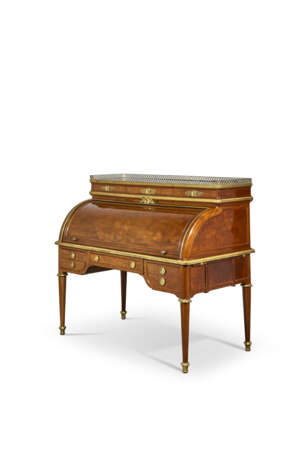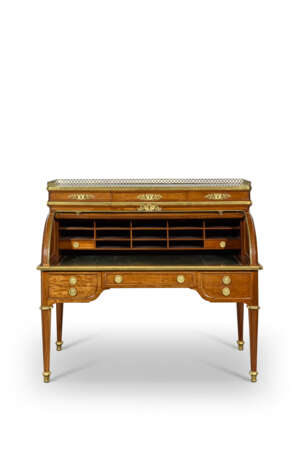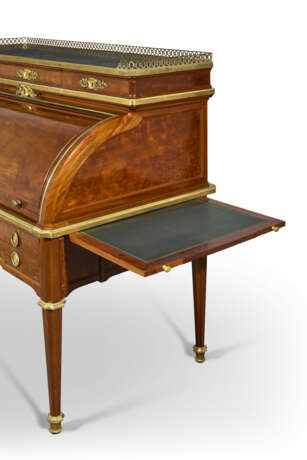ID 1329892
Los 28 | BUREAU À CYLINDRE D'ÉPOQUE LOUIS XVI
Schätzwert
€ 70 000 – 100 000
ESTAMPILLE DE JEAN-HENRI RIESENER, VERS 1780
En acajou, placage d'acajou et ornementation de bronze ciselé et doré, le plateau rectangulaire de marbre Turquin ceint d'une galerie ajourée sur un fronton ouvrant par trois tiroirs, le cylindre découvrant treize niches et deux tiroirs latéraux dont un dévoilant un nécessaire à encre ainsi qu'une tablette d'écriture gainée de cuir vert ceint d'une frise de grecques dorée à la roulette, la ceinture ouvrant par cinq tiroirs en façade et deux tirettes d'écriture latérales, sur des pieds en gaine octogonaux, estampillé deux fois 'JH RIESENER' sous les traverses latérales
H. 131 cm. (51 ½ in.) ; L. 150 cm. (59 in.) ; P. 76 cm. (30 in.)
Jean-Henri Riesener, reçu maître le 23 janvier 1768.
Literature
Bibliographie comparative :
Cat. exp. Jean-Henri Riesener, cabinet maker to Louis XVI & Marie-Antoinette, The Wallace Collection, Londres, 2020.
Further details
A LOUIS XVI ORMOLU-MOUNTED MAHOGANY CYLINDER DESK, STAMPED BY JEAN-HENRI RIESENER, CIRCA 1780
The excellence and refinement of Riesener, a testament to Oeben and English Neoclassical Traditions
Born in 1734 in Gladbeck, Aachen, Jean-Henri Riesener moved to Paris in 1754 to work in the workshop of another German cabinetmaker, Jean-François Oeben. This desk clearly reflects the influence of his master, with a shape inspired by the cylinder desks pioneered by Jean-François Oeben in the 1760s, featuring a cylindrical upper section that conceals two rows of drawers and shelves positioned above a writing surface. In 1760, Louis XV commissioned Oeben to create a cylinder desk, the Bureau du Roi (The King’s desk) for his private study in Versailles – a piece Oeben would never complete, as he passed away in 1763. Subsequently, Riesener took over the workshop, completed the commission, delivering it to the king in 1769, and was awarded the title of master cabinetmaker that same year. The exceptional craftsmanship of this desk established it as one of the most renowned pieces of furniture worldwide, earning Riesener the admiration of Pierre-Élisabeth de Fontanieu, Intendant and Head of the Garde-Meuble Royal – the royal furniture repository – who played a key role in his appointment as a supplier to the Garde-Meuble de la Couronne from 1774 to 1785. From then on, orders from the Court poured and Riesener delivered to Marie-Antoinette, the Count and Countess of Provence, the Count of Artois, the Duke of Orléans, and Mesdames, the King’s aunts, as well as to the great lords of the kingdom and the tax farmers-general.
Rather than an opulent structure richly inlaid with marquetry, Riesener cautiously opted for an elegant structure adorned with a fine mahogany veneer. The refinement of the piece is underlined by tapered legs, each featuring eight alternately flat and concave sides, embellished by ormolu rings and frames. The elegance and sobriety of this desk are characteristic of the mid-1780s and the Anglomania movement that swept through France, influenced by neoclassical English furniture that was rich in mahogany. In 1784, Marie-Antoinette commissioned a set of furniture in this wood from Riesener to furnish her new ground-floor apartments in Versailles, while Thierry de Ville-d’Avray, the new director of the Garde-Meuble, spent over 20,000 pounds decorating his apartment in the Garde-Meuble offices, mostly with mahogany. That same year, Riesener produced at least five cylinder desks from this material for members of the Court. This desk reflects the style of the Riesener furniture produced in the 1780s: a slender structure, highlighted by ormolu ornamentation reserved for functional elements such as galleries, handles, lock escutcheons and frames. It is also embellished with carefully selected mahogany, displaying a moiré pattern on the cylinder and a speckled finish on the drawers. During this period, his creations were characterised by graceful, feminine designs, referred to as “Etruscan” or “Roman”. These pieces were remarkable not only for their mottled, veined, or moiré mahogany but also for the quality of the bronzes and woods used. For instance, Riesener selected extremely slow-growing oak for his drawers, ensuring their durability and solidity.
Although cabinetmaker Guillaume Benneman, who was also German, soon became the preferred choice at the Garde-Meuble Royal on account of his more reasonable prices, Riesener retained the favour of the Queen, who continued to place orders with him for her Fontainebleau and St. Cloud residences. Jean-Henri Riesener not only furnished salons and state rooms but also decorated the private and intimate apartments of sovereigns and princes, along with those of a broad private customers. He thus designed simpler, less expensive pieces of furniture that retained the excellence of Riesener through certain refinements, such as the low-relief projection of the central drawer here, accentuating the line of the other drawers.
The ingenious mechanisms and production strategies devised by the cabinetmaker
The desk is also unique on account of the ingenuity and craftsmanship of its mechanisms. Its spring-loaded opening mechanism and complex locking system prevent the bottom drawers from being accessible when the cylinder is not fully open, allowing several drawers to be closed simultaneously. Similarly to a cylinder desk attributed to Jean-Henri Riesener housed in the Wallace Collection in London, this desk has a secret compartment, only accessible when the lower shelf is removed. The cylinder also features an ingenious mechanism that differentiates it from a conventional roll top, as the slats shaping it are irremovable and the entire cylinder slides into grooves to disappear inside. Riesener likely inherited his mastery of mechanisms from his master Oeben, who was appointed “Mechanic to the King” in 1760. The cylinder desk designed by Oeben for Louis XV was fitted with an exceptionally intricate mechanism, for which Riesener assumed responsibility when he completed the commission following Oeben’s death. Riesener also collaborated with Pierre II Destriches, who contributed to the mechanical tables at the Château de Choisy and Trianon, and with the furniture mechanic Jen-Gotfritt Mercklein, for the most complex metal systems. The perfection of this desk’s mechanisms is so advanced that a comparable model, exhibited by Sir Richard Wallace at Bethnal Green in 1875, was dated to the 19th century, as it appeared too modern for a late 18th-century creation.
Jean-Henri Riesener also demonstrated ingenuity in his production strategies. After the Bureau du Roi, he produced smaller, more comfortable models that required less time to produce in his workshops. He standardised the designs of his desks to a certain extent, enabling him to re-use the same plans for multiple orders, thereby increasing the efficiency of his production process. The desk commissioned for Mme Thierry de Ville-d’Avray in September 1784 adopted the same structure as those commissioned for Marie-Antoinette two months earlier. Similarly, the inner cabinet of this desk features the typical combination of drawers, niches and shelves, writing tablet and pulls, common to a series of comparable cylinder desks by Riesener, such as three sold at Christie’s, in Paris on 10 September 2018 (lot 18), in New York on 21 and 22 October 2010 (lot 467), and in London on 4 July 1996 (lot 350).
His ingenious production strategy allowed him to effectively overcome the challenges of the revolutionary crisis. When the French Revolution erupted, part of his customers fled France, leaving Riesener short of orders. As a result, he began training his workers to manufacture rifle butts, adapting to the new regime. In 1793, along with painters Jacques-Louis David and Hubert Robert, he was appointed as a member of a commission of expert artists tasked with appraising artworks seized from emigrants who had fled the country. During the Château de Versailles furniture sales ordered by the Convention, he repurchased some of the pieces he had previously delivered to the Garde-Meuble to resell them, while simultaneously producing pieces of furniture in the Directoire style.
The influence of Riesener on shaping the history of taste
While Jean-Henri Riesener played a significant role in the history of furniture during the reign of Louis XVI, his posthumous influence on collectors and cabinetmakers in subsequent centuries has been equally considerable. In the 19th century, four of the greatest English collectors initiated an exceptional enthusiasm for his works in England: George Watson Taylor, George IV, the Marquess of Hertford and Ferdinand de Rothschild. While George Watson Taylor was among the first collectors of these masterpieces, six were acquired by King George IV at the owners’ sale in 1825 to furnish the new royal apartment at Windsor Castle. The Marquess of Hertford acquired at least twenty pieces by Riesener or in his style. A few decades later, Ferdinand and Alice de Rothschild assembled eleven pieces attributed to the cabinetmaker for Waddesdon Manor, which now holds the largest collection of Riesener pieces in Great Britain. At the end of the 19th century, this trend spread to the United States, influenced by the Duveen brothers, English art dealers. Their customers included several American bankers and industrialists eager to raise their social status by emulating the aristocratic lifestyle initiated by the Rothschild family. While his pieces epitomised French elegance and exceptional craftsmanship, across the Atlantic they were primarily associated with Riesener’s ties to Marie-Antoinette and a fascination with the ancien régime.
Riesener also significantly influenced European cabinetmakers of his era, including the German David Roetgen, whose similar cylinder desk was sold at Sotheby’s in London on July 4, 2018 (lot 23); Fidelys Schey, whose comparable desk was auctioned at Sotheby’s in Paris on June 26, 2024 (lot 59); and, long after his death, François Linke, whose analogous cylinder desk was sold at Sotheby’s in Paris on June 22, 2023 (lot 13).
| Adresse der Versteigerung |
CHRISTIE'S 9 Avenue Matignon 75008 Paris Frankreich | ||||||||||||||
|---|---|---|---|---|---|---|---|---|---|---|---|---|---|---|---|
| Vorschau |
| ||||||||||||||
| Telefon | +33 (0)1 40 76 85 85 | ||||||||||||||
| Fax | +33 (0)1 40 76 85 86 | ||||||||||||||
| Nutzungsbedingungen | Nutzungsbedingungen | ||||||||||||||
| Versand |
Postdienst Kurierdienst Selbstabholung | ||||||||||||||
| Zahlungsarten |
Banküberweisung | ||||||||||||||
| Geschäftszeiten | Geschäftszeiten
|












